
The young European couple were enjoying their first Florida vacation. They’d completed their map study and their online research, but nothing could have prepared them what was waiting in the waters of Crystal River.
Peering through dive masks, they scanned the clear, spring-fed bay. Early morning light danced through the water column, refracting and distorting their vision, but suddenly, they saw it.
A hulking figure larger than their combined mass emerged from the shadows and headed straight for them. Realizing they could not outrun the creature, they froze in place as the giant drew closer, closer, closer.
There was no escape, the creature was upon them.
With nothing to stop it, the leviathan closed the remaining distance and — wiggled its whiskers as if to say: “Hello manatee watchers. Nice to meetcha.”
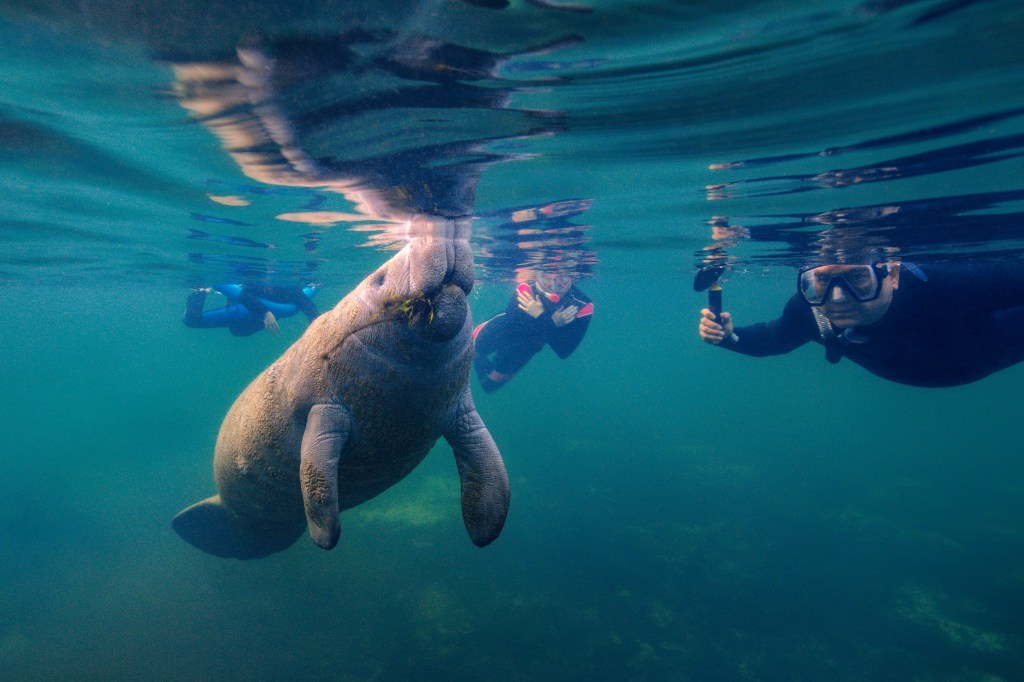
Meet-n-greet
Tyler Cook, who guides manatee tours for Fun2Dive, said this is common behavior from the docile marine mammals with poor eyesight. That means they have to swim nearly nose-to-nose with people just to see who they’re looking at.
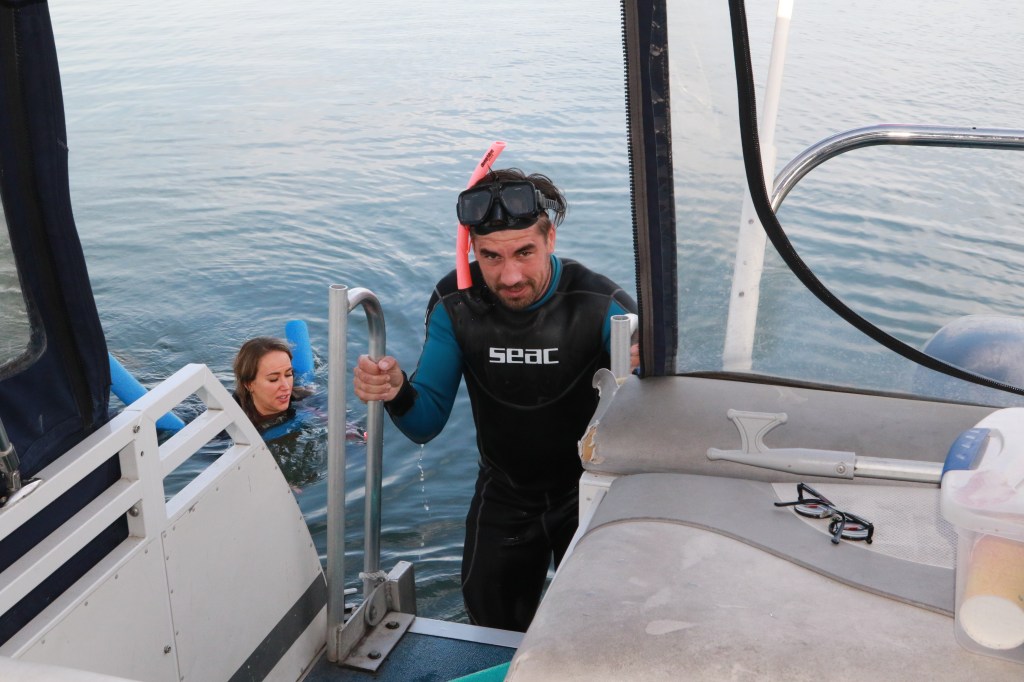
Just don’t panic. Recoiling is not only unnecessary, it’s a real bummer to a pretty friendly creature.
“If a manatee approaches you, they chose to do so,” Cook said. “If they approach, their instinct is to do so face-first, so you’ll have (an enormous) animal right in front of you.
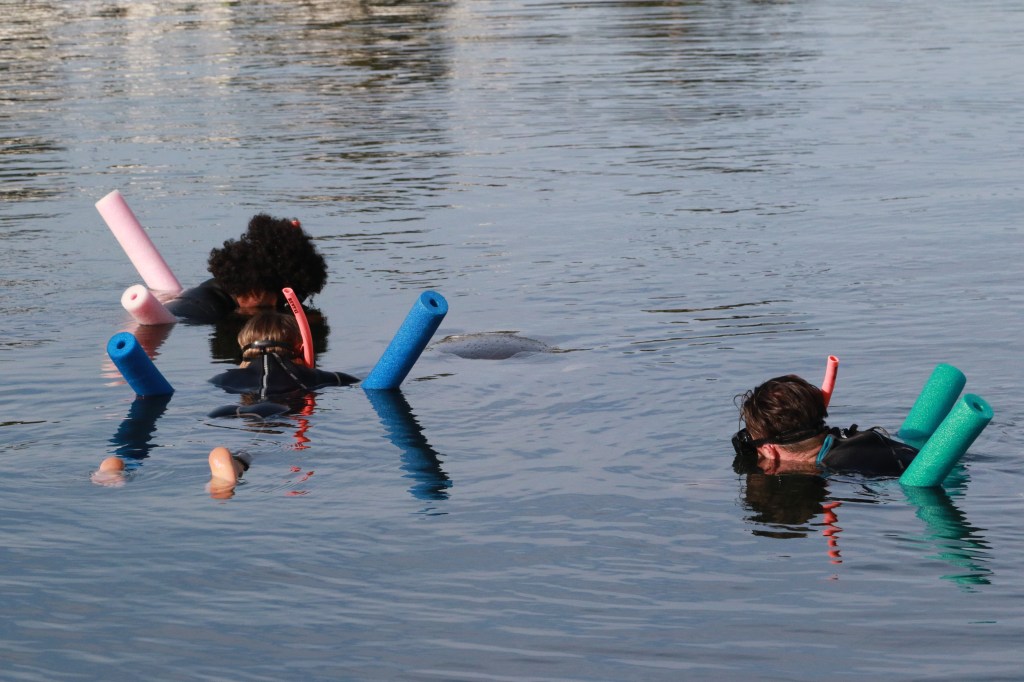
“If you push away, they’ll give you the saddest face you’ve ever seen, so don’t make a manatee cry.”
Cook said the best response to an approaching manatee is a calm, still posture. Just like horses, manatees are good at reading a person’s vibe, so relax and let the moment happen.
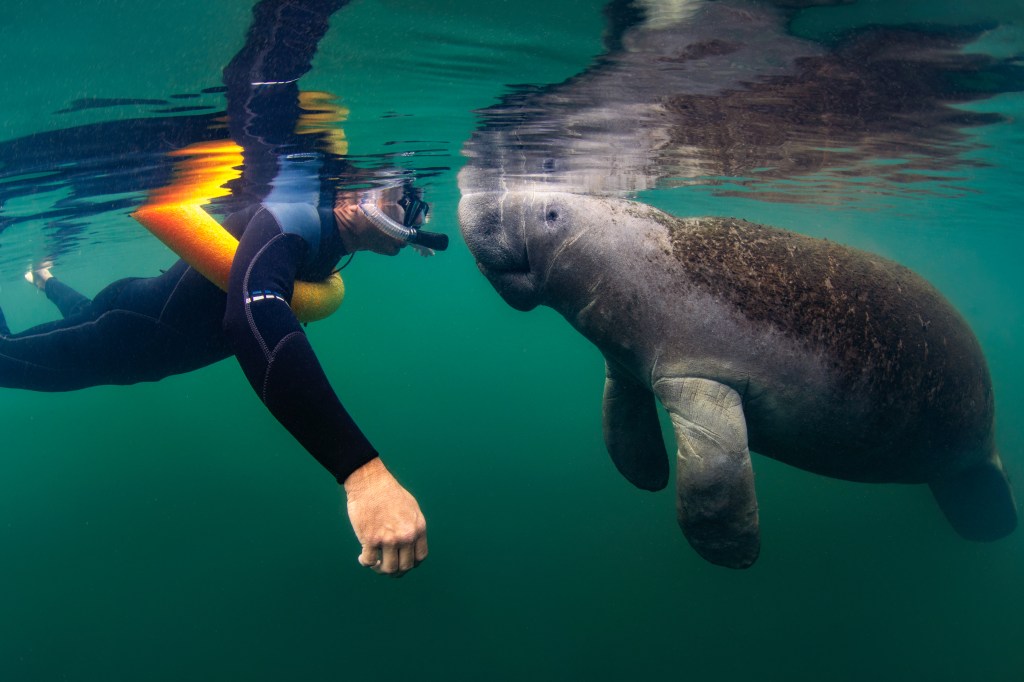
“With them being able to feel your heartbeat from 8 feet away in the water, if you’re excited and your heart rate is increasing, they’re going to feel that and they’ll be a little more skittish,” Cook said. “If they are curious and wanting to interact with you, they kind of give you the same mannerism a dog would.
“They’ll duck their heads down and look up at you, they’ll give you those little eyes. From there, the best thing is to just look at that animal. If that animal can see what you are, that’s when you’re going to get those interactions.”
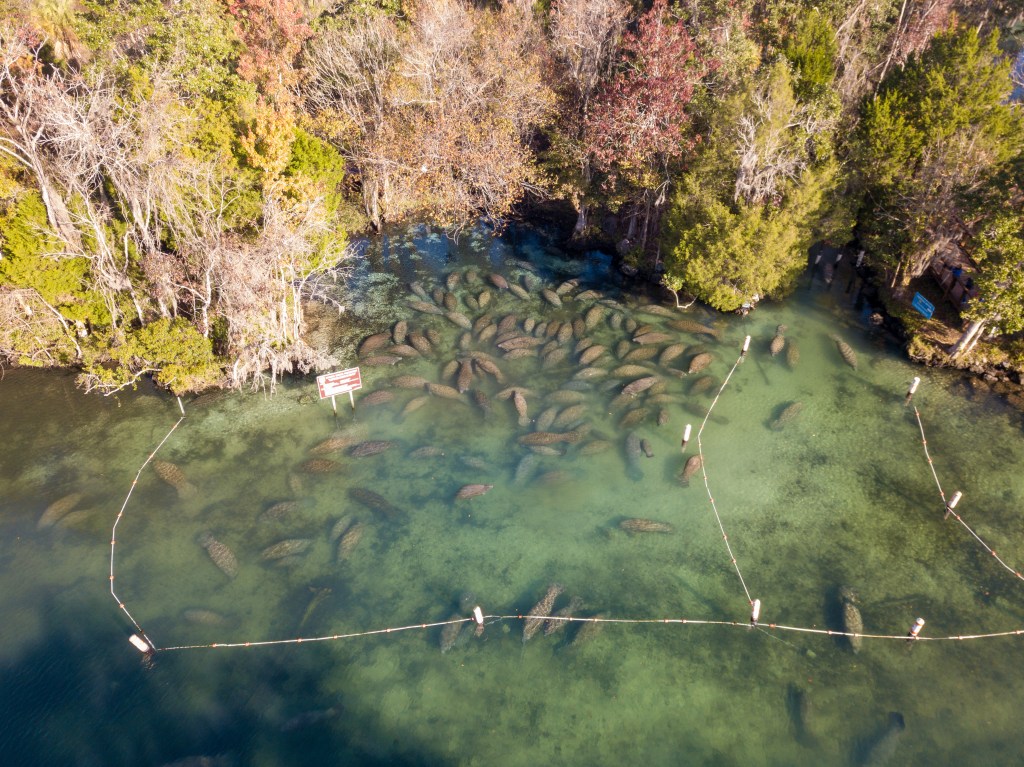
Where/When
Such encounters are the stuff of Florida vacation dreams and Crystal River is the undisputed “Manatee Capital of the World,” thanks to the 40 natural freshwater springs tucked within Kings Bay Manatee Refuge.
Part of the greater Crystal River National Wildlife Refuge and headwaters to its namesake river, the Kings Bay Manatee Refuge is the only federally protected area created solely for these gentle giants. Often called “sea cows” for their grass grazing diets, manatees share the same temperature sensitivities as any warm-blooded mammal, and that defines Crystal River’s magnetic appeal.
Fed by Florida’s limestone aquifer, the Kings Bay spring water remains 72 degrees year-round. Manatees spend much of the year roaming Gulf shallows, but late fall through winter finds them seeking warmth in coastal rivers and canals. Kings Bay’s consistent coziness annually hosts upwards of 1,000 manatees, so if you’ve always wanted to see these instantly endearing animals — Crystal River is the place to go.
Prime manatee viewing season usually spans November through March, weather depending. The Kings Bay population peaks between December and January, with a gradual dwindling once spring warms Gulf waters.
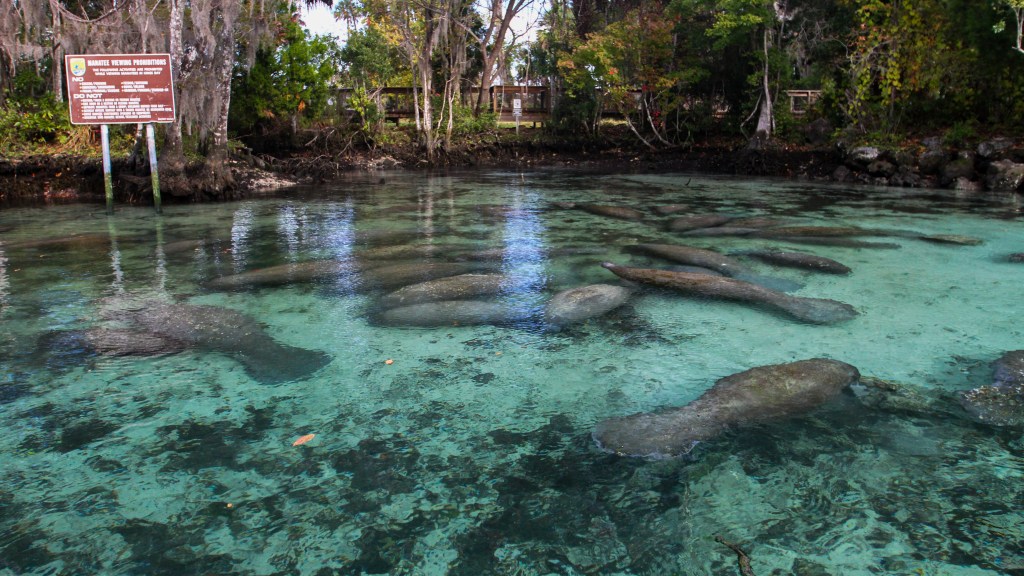
During the cold season, buoy lines restrict entrance to the springs, as manatees need this warming solace. You can still view resting manatees from a boat or in the water, but peripheral areas offer plenty of interactions with the ones out for a leisurely swim.
Something to consider: Cold weather concentrates manatees, but it also increases the number of people visiting Crystal River. Nothing wrong with crowds, as tour operators like Fun2Dive manage the traffic and strictly adhere to state regulations created to protect manatees.
However, the “off season,” — spring through fall — offers the classic quality-over-quantity proposal. As Fun2Dive boat captain Jake Deneef points out, there’s always resident manatees lounging around the springs.
The ones that figure out they have plenty of feeding opportunities in a pretty cozy area forego the long swim to Gulf waters and spend their time grazing and lazing in the Kings Bay area.
“If you just want to check off seeing a manatee from your bucket list, then (the cold season) is the time to be here,” Deneef said. “But if you want to see a manatee doing what a manatee does, spring is the best time to come.”

How to see them
Private boats and paddle craft are allowed throughout Kings Bay, with the exception of restricted areas. King Spring, the bay’s largest and deepest, attracts the greatest density of manatees, but an extensive boardwalk with observation platforms around Three Sisters Springs Wildlife Sanctuary offers land-based manatee viewing. (Sanctuary waters are accessible by paddle craft from Kings Bay, but there is no land access from inside.)
For an authentic Florida manatee encounter, Fun2Dive offers a convenient all-inclusive service with snorkel gear, wet suits, transportation to/from a covered pontoon boat docked at a local marina. Onsite, rinse and fit your mask, grab a pool noodle for the required surface flotation and use your hands — avoid noisy kicking — to propel and steer yourself into position.
During winter’s aggregations, it’s impossible to miss the manatees, but as spring thins their numbers, many swim to the Gulf, while the ones that remain scatter throughout Kings Bay.
Tour boats always check the springs, but when the trip requires a search, manatees disclose their location with a few distinct clues.

Nose: Manatees can remain submerged for up to 20 minutes, but as they come up for air, only their nose breaks the surface. Look for a gray ball about the size of your fist with two holes and whiskers.
Propulsion: When a manatee swims near the surface, its round, flat tail leaves a distinct circular signature known as the “footprint.” Tracking the print’s speed and spacing indicates a manatee’s course and mood.
Bubbles: Consuming grass all day has a certain gastric impact and, well, there’s no easy way to put this: Manatees fart. A lot.
Listen: As Cook points out, a manatee chewing grass sounds like someone crunching an apple under water.
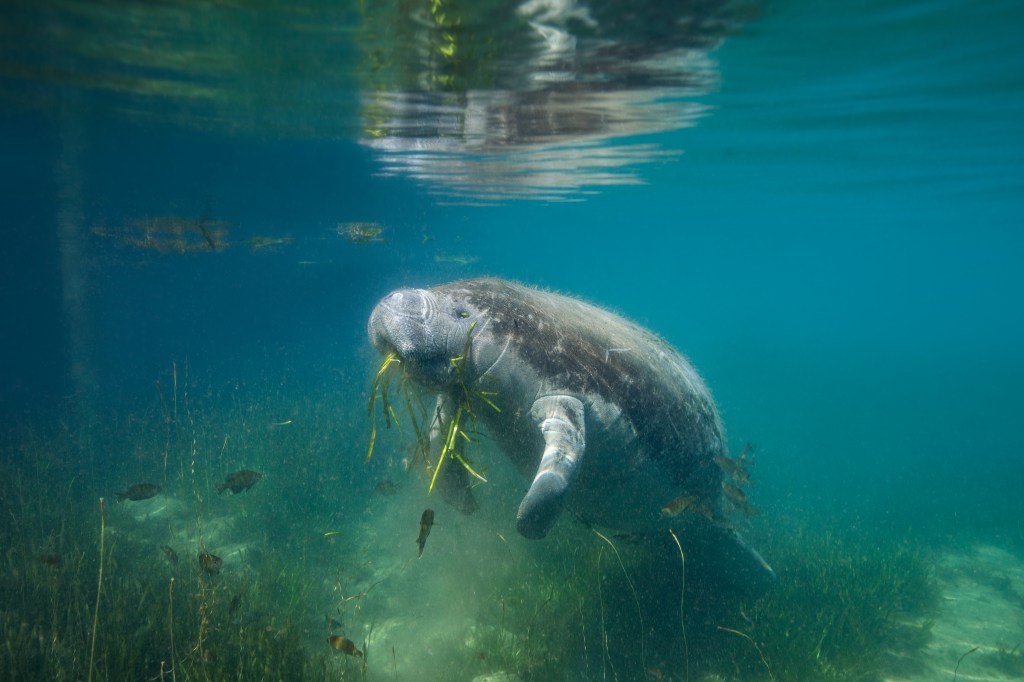
Care for the animals
Along with the fun stuff, manatee visitors must heed federal regulations intended for this protected species’ safety and comfort. Prior to guided trips, visitors must confirm that they’ve viewed the U.S. Fish & Wildlife Service’s “Manatee Manners” video, available on YouTube. (The USFW offers a Crystal River NWR summary here: https://www.fws.gov/sites/default/files/documents/CrystalRiverTearsheet16.pdf)
Cook said most visitors share a well-mannered fascination for Crystal River’s star attraction. However, manatee guides strive to balance the animals’ safety and tranquility with visitor fascination.
“The Manatee Manners video really does emphasize not (initiating contact) with these animals and giving them their space,” Cook said. “While we’re out here, it’s really kind of navigating those fine lines. We are, technically, allowed to touch these animals if they interact with us and that’s one of those things that people do come out here and look for.
“If you can come out and have a little baby manatee playing with you, it really is the most special thing in the world. But you also do want to be very careful.”
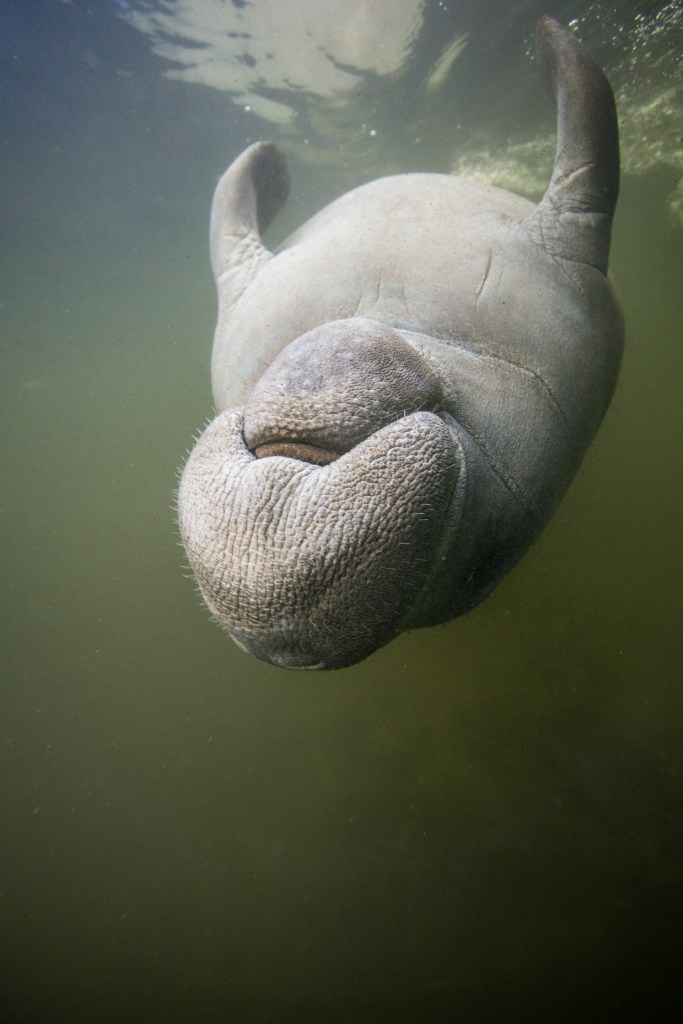
The key phrase is “passive observation.” Manatees have no natural predators and they’re often adorably curious. Many enjoy back scratches and some will roll over for a belly rub.
But here’s the overarching rule: The manatee must initiate the approach and the contact. Even then, manatees are not toys; they’re living creatures that reward respectful treatment with unforgettable moments.
Imagine walking your dog in public and consider the behaviors you’d find offensive/harassing — poking, pulling, kicking, chasing. Remember, manatees are federally protected and the folks with badges take this very seriously.

Volunteer manatee observers, identified by their green vests, kayak through Kings Bay to help ensure a positive experience for all. In Cook’s view, leading by example and communicating a genuine appreciation for these amazing creatures typically keeps everyone on the same page.
“I think the biggest thing is coming across as being passionate about it, rather than lecturing people,” Cook said. “I believe if you love what you do and you can project that, people are going to be more likely to listen to you and not go behind your back and do malicious things with these animals.”
Trip planning
For manatee tours, visit www.fun2dive.com.
For information about the Three Sisters Springs property and boardwalk, visit: threesistersspringsvisitor.org
For Crystal River’s lodging, dining, and activities, visit https://www.discovercrystalriverfl.com.




